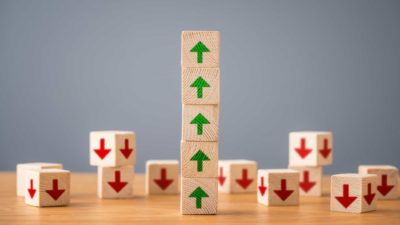Buy low, sell high, cash out, take profits…
Everyone knows that ASX investing is really about making money at the end of the day. No one buys shares hoping to lose money (except maybe short sellers).
But what actually makes shares go up in price? People who don't understand how the market works might just say it's chance and you'll have to 'get lucky'.
But this is not the case at all.
In theory, a company's share price (remember a share is really a small slice of a business, not just a symbol on a screen) is affected by 2 things at the end of the day: how much cash it generates and how much investors are willing to pay for that cash.
We normally measure the former by a metric knows as 'earnings per share' or EPS for short. A stock's EPS represents how much money (or 'earnings') you as the owner receive on paper for each share of the company you hold.
Now, this shouldn't be confused with dividends. Dividends are cash payments that are usually drawn from earnings, but don't represent the total amount of return you get as an investor. Most companies keep a chunk of earnings for reinvestment in future growth, which is technically your money as well.
Let's look at an example. Last year the shareholders of Commonwealth Bank of Australia (ASX: CBA) received $4.69 in EPS from each CBA share held. Out of this $4.69, $4.31 was paid as a dividend, which means CommBank kept $0.38 cents per share to reinvest back into the business.
But that's just one part of the equation. Investors also decide how much they're willing to pay for each dollar of earnings from a particular company. This is normally measured by a metric called the price-to-earnings ratio (often called P/E ratio).
This is simply the share price of a company divided by its EPS.
So let's say Company A makes $1 of earnings per share each year and investors decide they are willing to pay a P/E ratio of 25 for a share of Company A. That would price Company A shares at $25. If the company grows its EPS to $2, investors would either decide to keep paying 25 times those earnings ($50 a share) or pay a higher or lower P/E. Thus, these are the only 2 things that really impact a stock's price.
If we take CBA shares again, they last traded for a price of $81.20 (at the time of writing).
Because we've already worked out the EPS of CommBank ($4.69), the company's P/E ratio would just be $81.20 ÷ $4.69.
Lo and behold, we have a P/E ratio around 17.
Investors are willing to pay more per dollar of earnings for some companies than others. CommBank is a big company without too much growth ahead of it, so investors are willing to pay less for each dollar CommBank makes.
If we take a newer, high-growth company like Altium Limited (ASX: ALU), we would get a P/E ratio of around 60. Investors are willing to pay far more for a dollar of earnings from Altium because they think that Altium is going to grow faster and deliver more dollars in earnings down the road than a company like CommBank.
Foolish takeaway
Now you understand why share prices of ASX companies go up and down – it's the market constantly re-evaluating how much it wants to pay for each dollar of earnings a company is producing.
So now, your only job is working out what you're willing to pay for your favourite ASX shares!







